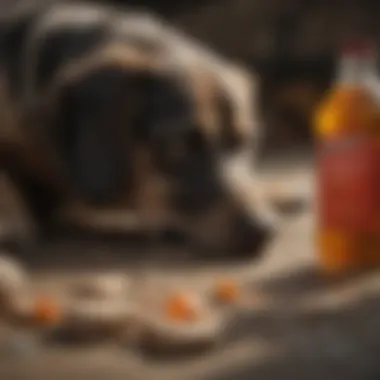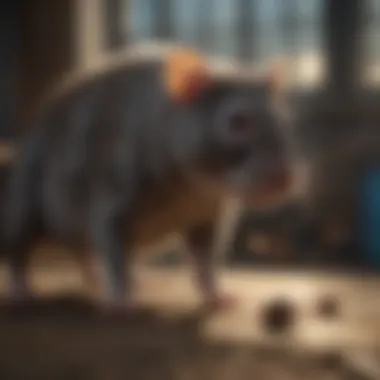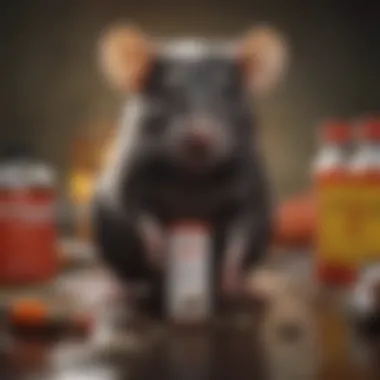Dog Emergency: What to Do If Your Dog Eats Rat Poison


Intro
The well-being of our pets is paramount, and understanding the potential risks they face is essential for any responsible owner. One significant hazard is rat poison. It is a common substance used in pest control, yet it poses a severe risk to dogs if ingested. Immediate response and knowledge about the situation can mean the difference between life and death for an affected animal. This comprehensive guide provides critical insights for dog owners, including what steps to take if their pet consumes rat poison, how to recognize symptoms of poisoning, and how to prevent these situations from occurring in the first place.
Fascinating Facts About the Animal
In understanding the unique characteristics of dogs, we come to appreciate their role as companions. Dogs are known for their acute sense of smell. They can detect scents at concentrations nearly 100 million times lower than what humans can. This ability is partly what makes them prone to explore and consume items that they should not. Their curious nature often leads them into dangerous situations, including the ingestion of harmful substances like rat poison.
Unique Characteristics
Dogs, as domesticated species, exhibit diverse traits that vary by breed. Generally, they have strong social bonds with humans and can learn a variety of commands and tasks. Their intelligence can be surprising, as some breeds are particularly adept at problem-solving and learning new tricks quickly. This versatility makes them cherished family members yet also sometimes vulnerable to hazardous exposure.
Extraordinary Abilities
One of the more extraordinary abilities of dogs lies in their aptitude for detection. Many organizations leverage this skill, employing dogs in search and rescue missions, detecting drugs or explosives, and even identifying medical conditions in humans, such as low blood sugar or seizures. These abilities contrast with their potential to consume dangerous materials, such as rat poison, highlighting the need for vigilance in caring for them.
Behavior and Habitat
Dogs, being social animals, thrive in environments that support their social structure. They usually inhabit areas close to humans, where they find food, companionship, and necessary resources. Their behavior is influenced by domestication, training, and their innate instincts.
Natural Habitats
Domesticated dogs are typically found in human homes, providing companionship and protection. However, in nature, feral dogs tend to roam in packs, exhibiting behaviors similar to wolves, the species from which they evolved. This underscores their instinctual behaviors, which can lead to dangerous exploration.
Social Structures
Dogs are pack animals. This means they naturally form social hierarchies and bonds with both humans and other dogs. When a dog is in a household, it sees its human family as part of its pack. Instances of separation from their pack, or their human families, can lead to anxiety and exploration for new sources of food, which can result in ingesting harmful substances.
Recent Scientific Discoveries
Ongoing research in veterinary science uncovers more about the effects of various poisons on canine physiology. This research is critical for developing better treatment protocols and preventive measures for pet owners and veterinarians.
Latest Research Findings
Studies show that rodenticides vary in their chemical composition, with some being more toxic than others. Certain anticoagulants can cause severe internal bleeding. Understanding these findings helps ascertain quicker treatment responses.
Breakthroughs in Animal Biology
Recent breakthroughs also focus on how poison interacts with canine metabolism. Understanding how a dog's body processes these chemicals allows for better treatment regimens in veterinary practice. This knowledge contributes to enhancing emergency care for affected dogs.
Cultural Significance
Dogs have held a unique place in many cultures throughout history, featuring prominently in literature, folklore, and art. Their roles extend from loyal companions to mythical creatures symbolizing various human traits.
Animals in Folklore
In many cultures, dogs symbolize loyalty and protection. Folklore often depicts them as guides for souls in the afterlife or as creatures bearing messages. Their representation across diverse stories reinforces the bond between humans and dogs over centuries.
Influence on Art and Literature
Whether painted in artworks or featured in stories and poems, dogs have inspired countless generations of artists. Their presence in literature often reflects their loyalty, companionship, and protective instincts, serving as powerful metaphors for human emotions.
Understanding the various aspects of canine behavior, their roles in culture, and their biological responses to toxins is essential for any dog owner. This knowledge forms the foundation for effectively addressing emergencies, particularly when faced with the grave risk of rat poisoning.


Foreword to Pet Poisoning
Pet poisoning is a pressing concern for dog owners. Understanding its implications is vital to ensure the safety and health of pets. Rat poison is particularly dangerous, often available in homes where dogs reside. When a dog ingests rat poison, it can lead to critical health issues. This article aims to shed light on the risks posed by rat poison and subsequent actions to take in such emergencies.
Understanding the Risks of Rat Poison
The dangers of rat poison cannot be understated. It is toxic for various animals, including dogs. The risk intensifies due to the inconspicuous nature of poison places in homes. Many rat poisons contain harmful chemicals that impair blood clotting or cause organ failure. Moreover, ingestion can often go unnoticed initially. Therefore, awareness and knowledge about these risks are crucial for dog owners.
Common Types of Rat Poison
There are several types of rat poison available in the marketplace. Here, we discuss three primary types that dog owners should be aware of:
Anticoagulants
Anticoagulants are types of rat poison most widely used. They work by preventing blood from clotting, leading to internal bleeding in affected animals. A key characteristic of anticoagulants is their delayed effect. Symptoms may not show for several days after ingestion. This makes them particularly insidious. Despite their effectiveness against rodents, their use poses significant risks to dogs that might accidentally ingest them. An advantage of anticoagulants is their relatively easy identification in poisoned animals, which can aid in timely treatment.
Bromethalin
Bromethalin is another powerful rat poison. Its mode of action affects the nervous system. High doses can lead to severe neurological symptoms in dogs, such as seizures or paralysis. A key aspect of bromethalin is its rapid onset of action. Dogs may exhibit symptoms within hours of ingestion. This quick response necessitates prompt action for treatment. However, the effects can be permanent in some cases, leading to serious concerns for pet owners.
Cholecalciferol
Cholecalciferol, or vitamin D3, is utilized not just for its beneficial properties. In the context of rat poison, it leads to increased calcium levels, which can result in organ failure if ingested in significant amounts. It is notable for causing hypercalcemia. Symptoms can take days to manifest, but once they do, they may include vomiting or lethargy. The unique feature of cholecalciferol is its potential to cause extensive damage before the owner realizes a problem exists. Therefore, understanding these characteristics aids in prevention and treatment strategies.
Symptoms of Rat Poisoning in Dogs
Recognizing the symptoms of rat poisoning in dogs is crucial for prompt and effective treatment. Early detection significantly increases the chances of recovery. Understanding the signs helps pet owners to act swiftly and make informed decisions about veterinary care. Being observant can save a life. Symptoms can vary depending on the type of poison ingested and the quantity. Immediate knowledge empowers dog owners, potentially preventing severe health issues for their pets.
Early Signs of Poisoning
The early signs of poisoning are often subtle. Symptoms may manifest within hours or even days after ingestion. Noticing these early indicators can be pivotal during the crucial first moments. Common initial symptoms include:
- Lethargy: Your dog may seem unusually tired or uninterested in activities they usually enjoy.
- Loss of Appetite: A sudden disinterest in food can often be a red flag for many health concerns, including poisoning.
- Vomiting: This may occur shortly after ingestion as the body tries to eliminate the harmful substance.
Should you observe any of these signs, monitor your dog closely. It is advisable to maintain contact with your veterinary provider during these early signs.
Advanced Symptoms to Watch For
As the situation progresses, symptoms can escalate into more severe manifestations. Knowing what to anticipate catches complications earlier.
Neurological Symptoms
Neurological symptoms can indicate serious toxicity. Dogs might exhibit:
- Seizures: Involuntary muscle contractions can be alarming and require immediate medical attention.
- Disorientation: Affected dogs might seem lost or unable to recognize family members.
- Tremors: Shaking can indicate overstimulation of the nervous system.
These symptoms are vital markers indicating systemic impacts of the poison. Recognizing them early can lead to timely intervention, which is critical for better prognosis.
Gastrointestinal Distress
Gastrointestinal distress includes:
- Diarrhea: This can happen due to irritation in the intestine. It rapidly leads to dehydration, one of the more dangerous outcomes.
- Abdominal Pain: Dogs may show signs of discomfort or sensitivity when touching their stomach.
Understanding these symptoms allows owners to gauge the distress level of their canine companions and react accordingly. Immediate veterinary contact is recommended for any lingering gastrointestinal symptoms.


Timeframe for Symptoms to Appear
Awareness of the timeframe for symptoms to appear is essential for pet safety. Different rat poisons have varying onset times. Generally, symptoms can manifest anywhere from a few hours to several days post-exposure.
- Anticoagulants may show effects in 24 to 72 hours.
- Bromethalin may result in symptoms within a few hours.
- Cholecalciferol impacts can take longer, often appearing after 12 to 36 hours.
Being keenly aware of this timeline can inform pet owners about when to closely observe their dogs and when to seek immediate veterinary assistance.
Immediate Actions to Take
It is crucial for dog owners to understanding immediate actions to take if their dog ingests rat poison. Time is of the essence in these situations. Quick responses can significantly impact the outcome for the affected dog. Knowing the signs of poisoning and how to act can save lives.
Assessing the Situation
Before taking any action, assess the situation thoroughly. Gather as much information as possible. Identify the type of rat poison consumed, if known. This can help in determining the correct course of action. Consider the dog's condition. Is it showing any symptoms of distress? Observing the dog's behavior can provide crucial insights. If the dog appears fine, do not assume it is safe. The poison may still affect it internally.
Contacting a Veterinarian
After assessing the situation, the next step is to contact a veterinarian immediately. This is one of the most critical actions to take. Vet professionals have specialized knowledge in handling such emergencies. Provide them with details about the incident. Mention the type of poison if known, and describe the dog's condition. Following their instructions is essential. They may ask you to bring the dog in for treatment or guide you on what to do at home in certain situations.
Possible First Aid Measures
Immediate first aid can provide necessary help until professional assistance is available.
Inducing Vomiting
Inducing vomiting can be an important first aid measure. This process can help expel the poison from the dog's system before it is absorbed further. It is most effective if done within a short time after ingestion. However, it is not suitable for all types of poisons.
Note: Always consult a veterinarian before inducing vomiting.
The effectiveness of inducing vomiting lies in its speed. If it is done soon, it can prevent serious complications. However, there are risks. If the dog is showing signs of distress or has difficulty breathing, inducing vomiting can make the situation worse. In such cases, it's best to follow the vet's advice without attempting this step.
Activated Charcoal
Activated charcoal can also be used in some cases. It absorbs toxins from the gastrointestinal tract. This helps in preventing the poison from entering the bloodstream. It is a widely recognized treatment method for various types of poison ingestion.
Activated charcoal is beneficial due to its ability to bind with toxins. This makes it a popular choice during poisoning emergencies. However, it is not effective for all poisons, and there can be complications. The potential for aspiration if the dog vomits after receiving charcoal is something to keep in mind. Always reach out for veterinary guidance before administering activated charcoal.
Veterinary Treatment Options
When a dog ingests rat poison, immediate veterinary care is crucial. The veterinary treatment options available can be instrumental in mitigating the effects of poisoning. Understanding these options allows pet owners to make informed decisions that can greatly impact the outcome for their canine friends. The role of veterinarians becomes pivotal in diagnosing the type of poison and administering appropriate treatments. Timely intervention can significantly increase the chances of recovery and reduce long-term health issues.
Diagnostics and Testing Procedures
The first step in addressing rat poison ingestion is accurate diagnosis. Veterinarians employ a variety of diagnostics and testing procedures. This often begins with a thorough history taking and physical examination. Further diagnostics may include:
- Blood Tests: These tests help determine the extent of poisoning and assess organ function.
- Urinalysis: This may be performed to check for specific toxins.
- Coagulation Tests: Particularly important for anticoagulant poisonings, as these tests evaluate blood clotting ability.
Veterinarians may use imaging techniques like X-rays or ultrasound if there are concerns about gastrointestinal blockage. Quick and precise diagnostics lead to more targeted treatment protocols.
Treatment Protocols for Different Poisons
Antidotes


Antidotes are specific substances used to counteract the effects of poisons. In the case of rat poisoning, the most common antidote is Vitamin K1, particularly for anticoagulant rodenticides. This treatment can effectively reverse the effects on the clotting mechanism within a dog’s body. One key characteristic of antidotes like Vitamin K1 is its ability to promote the body’s natural clotting process.
The unique feature of administering an antidote is the timing. If given promptly, the benefits are substantial, significantly increasing the chances of recovery. However, it is important to note that not all toxins have an effective antidote, which can limit treatment options.
Supportive Care
Supportive care complements medical treatment and addresses the physiological needs of the dog. This may include IV fluids, nutritional support, and medications to manage symptoms. The key characteristic of supportive care is its role in stabilizing an affected pet while waiting for the primary poison to be addressed.
One of the advantages of supportive care is its broad applicability. It can be tailored to the individual needs of a dog based on the type of poison ingested and its symptoms. However, it can also have downsides, such as requiring long-term hospitalization, which can be stressful and costly for pet families.
Expected Recovery Timeframes
Recovery timeframes can vary dramatically depending on several factors. These include the type and amount of poison ingested, the speed of treatment initiated, and the overall health of the dog prior to the incident. Commonly, if a dog receives prompt care, the recovery may begin within a few days. However, some poisons may cause prolonged effects, requiring weeks to months for full recovery.
It is essential for owners to have ongoing communication with their veterinarian during this process. They can provide guidance on at-home care, monitoring the pet's condition, and follow-up diagnostics to ensure the pet is on the path to recovery. Vigilance during this recovery phase is crucial to detect any potential complications that may arise later.
Preventive Measures for Dog Owners
Preventive measures are critical for dog owners who want to safeguard their pets from the dangers associated with rat poison. By taking proactive steps, owners can create a safer living environment and reduce the risk of accidental poisoning. Understanding how to manage potential hazards is not only beneficial for the dog's health but also minimizes the responsibility of dealing with the consequences of such incidents. The following sections will outline specific strategies that can help dog owners mitigate risks effectively.
Safe Storage of Poisons
Proper storage of poisons is a foundational aspect of prevention. Rat poisons, cleaning supplies, and any chemicals should be kept in secure, locked cabinets. High shelves may also work, as long as it is not easy for pets to access these areas. Using child-proof locks can be effective, as they are not only designed for children but also provide an additional barrier for curious dogs.
When purchasing rat poison, consider opting for products with safety features. These may include packaging that requires some effort to open or formulations that are less attractive to pets. Keep in mind that even household items that are not labeled as poisons can be hazardous if ingested. Therefore, all potentially toxic substances should be regarded with caution.
Educating Family and Friends
Education plays a vital role in prevention. All family members, including children, should be informed about the dangers of rat poison. This conversation should include an understanding of what rat poison looks like and its potential effects on pets. Children should be taught not to leave snacks or food items that might lure a dog into areas where poison has been placed.
Moreover, when hosting guests, don’t hesitate to share your home's safety measures. Explain where poisons are stored, and highlight that pets should be supervised around these areas. It is important that everyone is aligned in keeping an eye on the dog, especially during gatherings or family events.
Alternative Rodent Control Strategies
To reduce the need for rat poison, explore alternative rodent control methods. These methods not only are safer but often more sustainable for the environment. Here are some options to consider:
- Physical Traps: Use snap traps or humane traps. These can effectively catch rodents without posing a risk to pets. Ensure that traps are placed in locations that are inaccessible to your dog.
- Natural Deterrents: Certain smells repel rodents. Consider using repellents like peppermint oil or vinegar, which are less harmful and can protect your dog.
- Habitat Modification: Eliminate food sources and nesting sites around your home. Store food in sealed containers and keep your space clean to avoid attracting rodents.
By employing alternative strategies, dog owners can significantly reduce the risks associated with traditional rat poisons. These tactics not only protect pets but also contribute to a healthier home environment, fostering peace of mind.
Preventive actions are not just about reacting to accidents. They require a consistent approach and awareness to keep our dogs safe.
The End
When facing a potential poisoning incident involving a dog and rat poison, the knowledge and readiness of a pet owner can significantly influence the outcome. This article emphasizes essential elements, such as recognizing symptoms of poisoning, the immediacy of seeking veterinary help, and the steps to take in case of an emergency. Understanding these factors not only aids in prompt response but also helps to alleviate the distress associated with such situations.
Understanding the importance of vigilance and awareness cannot be overstated. Being informed allows pet owners to establish a safer environment for their dogs, potentially preventing dangerous incidents. Familiarity with the various types of rat poisons and their effects on canine health empowers owners to act effectively when needed.
“An informed pet owner is the first line of defense against pet poisoning.”
Recap of Essential Steps
- Identify Symptoms: Monitor your dog for signs of poisoning such as vomiting, lethargy, or unusual behavior.
- Immediate Action: If poisoning is suspected, remain calm. Assess the situation and remove any access to further toxins, if safe to do so.
- Contact Veterinarian: Reach out to a veterinarian immediately. Providing them with details regarding the type of rat poison ingested will help guide treatment.
- Follow Vet's Advice: Follow the instructions given by the veterinarian, which may include bringing the dog in for treatment or administering first aid at home.
- Prevent Future Incidents: After handling the situation, take steps to prevent recurrence, such as securely storing rat poison and educating others about dangers.
The Importance of Vigilance and Awareness
Being vigilant is crucial for dog owners. Awareness of the surroundings and potential hazards can save a life. Rats and other pests might be part of a routine maintenance issue around a home; hence, understanding the implications of using rodenticides is imperative. Regular checks for rat poison placement, coupled with safety measures, can reduce risks.
Educating friends and family about the dangers that come with rodenticides is equally important. An informed community can contribute to overall pet safety.
In summary, maintaining vigilance and fostering awareness around pet safety is a continuous effort. It is not just about reacting to crises, but also about anticipating and preventing them.







